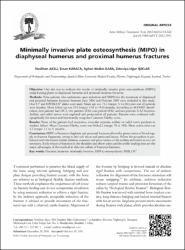Minimally invasive plate osteosynthesis (MIPO) in diaphyseal humerus and proximal humerus fractures
Künye
Aksu N, Karaca S, Kara AN, Işiklar ZU. Minimally invasive plate osteosynthesis (MIPO) in diaphyseal humerus and proximal humerus fractures. Acta Orthopaedica et Traumatologica Turcica. 2012; 46(3): 154-160 doi:10.3944/AOTT.2012.2592Özet
OBJECTIVE: Our aim was to evaluate the results of minimally invasive plate osteosynthesis (MIPO) using locking plates in diaphyseal humerus andproximal humerus fractures.
METHODS: Nine patients who underwent open reduction and MIPO for the treatment of diaphyseal and proximal humerus fractures between June 2006 and October 2009 were included in this study. One S3(®) and 8 PHILOS(®) plates were used. Mean age was 75.2 (range: 32 to 86) years and all patients were females. Mean follow-up was 33.9 (range: 14.8 to 54.8) months. According to AO/ASIF classification, four patients had 12C1, two patients 12A1, one patient 12A2, and two patients 11A2 fractures. Axillary and radial nerves were explored and protected in all patients. Patients were evaluated radiographically for union and functionally using the Constant-Murley score.
RESULTS: None of the patients had nonunion, avascular necrosis, axillary or radial nerve paralysis or implant failure. Mean Constant-Murley score was 86.8 ± 2.2 (range: 70 to 100). Mean union time was 3.2 (range: 2.5 to 5) months.
CONCLUSION: MIPO of humerus diaphysis and proximal fractures allows for preservation of blood supply in fracture fragments, owing to less soft tissue and periosteal injury. When the procedure is performed with the lateral double incision, exposure and preservation of the axillary and radial nerves are necessary. Early return of function in the shoulder and elbow joints and favorable healing time are the major advantages of this method in this rare subset of humerus fractures.


















